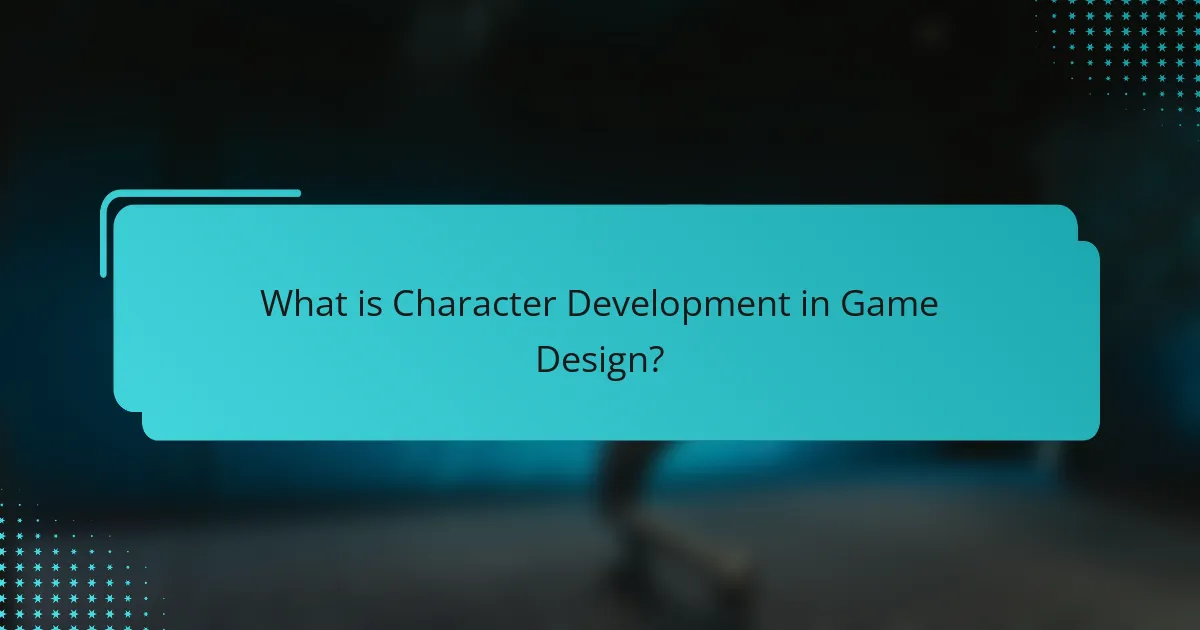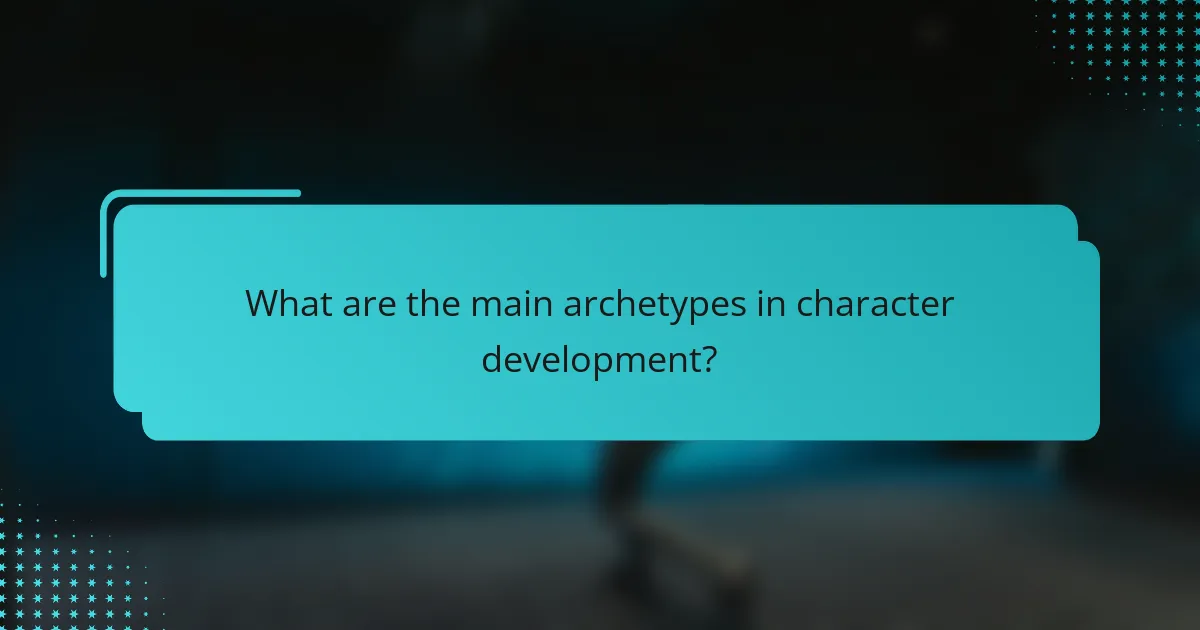
What is Character Development in Game Design?
Character development in game design refers to the process of creating and evolving characters within a game. This process involves defining a character’s personality, background, and motivations. Well-developed characters enhance player engagement and immersion. They often embody archetypes that resonate with players. Character development can include visual design, dialogue, and interactions. It also influences gameplay mechanics and story progression. Research shows that players connect more deeply with games featuring rich character development. This connection can lead to increased player satisfaction and retention.
How does character development influence gameplay?
Character development significantly influences gameplay by shaping player choices and emotional engagement. Well-developed characters provide depth to the narrative, enhancing immersion. Players often form attachments to characters, which can affect their decision-making. For example, a character’s backstory may lead players to make choices that align with their values. Additionally, character growth can unlock new abilities or story paths, directly impacting gameplay mechanics. Games like “The Witcher 3” illustrate this, where character decisions lead to varied endings. This connection fosters a more personalized gaming experience, making gameplay more meaningful.
What are the key elements of character development?
The key elements of character development include personality, backstory, goals, relationships, and growth. Personality defines how a character behaves and interacts. Backstory provides context for their motivations and choices. Goals drive a character’s actions and decisions throughout the narrative. Relationships with other characters influence their development and can create conflict or support. Growth refers to the changes a character undergoes, often in response to challenges faced in the story. These elements work together to create a believable and engaging character.
How do characters enhance player experience?
Characters enhance player experience by creating emotional connections and driving engagement. They serve as avatars for players, allowing them to immerse in the game world. Well-developed characters provide relatable motivations and backstories. This depth encourages players to invest time and emotions into the narrative. For example, a character’s struggles can mirror real-life challenges, fostering empathy. Research shows that players often feel a sense of attachment to characters, influencing their gameplay choices. A study by the University of Southern California found that character identification can enhance overall enjoyment and satisfaction. Thus, characters play a crucial role in shaping the player’s journey and experience.
Why is character development important in storytelling?
Character development is crucial in storytelling because it creates relatable and multi-dimensional characters. Well-developed characters engage audiences and evoke emotional responses. This connection fosters investment in the narrative. According to a study by the University of Southern California, character-driven stories enhance audience retention by 30%. Characters with clear motivations and arcs drive the plot forward. Their growth reflects real-life experiences, making stories resonate deeply. Ultimately, character development enriches the narrative and enhances the overall storytelling experience.
What role do characters play in player immersion?
Characters play a crucial role in player immersion by fostering emotional connections. They provide relatable experiences that engage players on a personal level. Well-developed characters enhance storytelling, making the game world more believable. Players often invest in characters’ journeys, which increases their emotional stakes. Studies show that emotional engagement with characters leads to deeper immersion. For instance, a study by Klimmt et al. (2009) found that players who identify with characters experience heightened immersion. This connection can drive players to explore game narratives more thoroughly. Ultimately, characters serve as the bridge between players and the game world, enhancing the overall gaming experience.
How do character arcs contribute to narrative depth?
Character arcs enhance narrative depth by showcasing a character’s transformation throughout the story. This transformation creates emotional engagement for the audience. It allows players to relate to the characters on a personal level. As characters face challenges, their growth reflects universal themes of struggle and change. This connection deepens the player’s investment in the narrative. Research indicates that well-developed character arcs lead to higher player satisfaction and immersion. For instance, a study by the International Game Developers Association found that players prefer narratives with complex character development. This preference underscores the importance of character arcs in enriching storytelling within games.

What are the main archetypes in character development?
The main archetypes in character development are the Hero, Mentor, Ally, and Villain. The Hero is the central character who embarks on a journey. The Mentor provides guidance and wisdom to the Hero. The Ally supports the Hero in their quest, often facing challenges together. The Villain opposes the Hero, creating conflict and driving the narrative. These archetypes are foundational in storytelling, as outlined in Joseph Campbell’s “The Hero with a Thousand Faces,” which explores the Hero’s journey across cultures. Understanding these archetypes enhances character depth and player engagement in game design.
How do archetypes shape player expectations?
Archetypes shape player expectations by providing recognizable patterns that guide behavior and engagement. Players often anticipate specific traits and narratives associated with archetypes. For example, a “hero” archetype typically embodies bravery and selflessness. This leads players to expect heroic actions and challenges. Conversely, a “villain” archetype suggests conflict and opposition. This shapes player expectations for encounters and story progression. Research shows that archetypes help streamline storytelling in games, making interactions more intuitive. Players are more likely to connect emotionally when archetypes align with their expectations. This connection enhances immersion and satisfaction in gameplay experiences.
What are the most common character archetypes in games?
The most common character archetypes in games include the Hero, the Mentor, the Villain, and the Sidekick. The Hero often embarks on a journey, facing challenges and growing throughout the story. The Mentor provides guidance and support to the Hero, often possessing wisdom and experience. The Villain opposes the Hero, creating conflict and driving the narrative forward. The Sidekick assists the Hero, often providing comic relief or additional skills. These archetypes are prevalent across various genres, reinforcing familiar storytelling structures. They help players connect with characters through shared motivations and traits.
How can archetypes be subverted for unique storytelling?
Archetypes can be subverted by altering their expected traits and roles. This approach creates unexpected character dynamics and plot developments. For instance, a typical hero can be portrayed as flawed or morally ambiguous. This subversion challenges audience expectations and fosters deeper engagement. Notable examples include the anti-hero in modern narratives, who often embodies both heroism and villainy. Such complexity enriches storytelling by introducing moral dilemmas. Additionally, subverting archetypes can highlight societal issues or personal struggles. This technique encourages audiences to rethink preconceived notions about character roles and motivations.
What is the significance of archetype diversity?
Archetype diversity is significant because it enhances character development in game design. Diverse archetypes allow for a broader range of narratives and player experiences. This variety fosters deeper emotional connections between players and characters. Research indicates that players engage more with games featuring diverse character representations. A study by Vasalou et al. (2008) found that players prefer games that reflect varied backgrounds and motivations. Archetype diversity also encourages inclusivity, appealing to a wider audience. This inclusivity can lead to increased player satisfaction and retention. Overall, archetype diversity is essential for creating engaging and relatable gaming experiences.
How does diversity in archetypes impact player connection?
Diversity in archetypes enhances player connection by providing varied representation and relatability. When players encounter diverse archetypes, they can identify with characters that reflect their own experiences or aspirations. This identification fosters emotional investment in the narrative and gameplay. Research shows that players are more engaged when they see characters that resonate with their personal backgrounds. A study by Kowert et al. (2015) found that diverse character representation leads to increased player satisfaction and connection. Ultimately, a broad range of archetypes enriches the gaming experience by catering to a wider audience and fostering inclusivity.
What are the challenges of incorporating diverse archetypes?
Incorporating diverse archetypes presents several challenges. One challenge is ensuring authentic representation. This requires thorough research to avoid stereotypes. Another challenge is balancing archetypes within the narrative. Unequal focus can lead to disengagement. Additionally, integrating diverse perspectives can complicate character development. Conflicting motivations may arise, requiring careful navigation. Developers must also consider audience reception. Misinterpretation of archetypes can lead to backlash. Finally, technical limitations may hinder the implementation of complex archetypes. These challenges necessitate a strategic approach to character design.

What motivates characters in game design?
Characters in game design are motivated by a combination of personal goals, external conflicts, and player interactions. Personal goals often stem from the character’s backstory and desires. These can include revenge, love, or the pursuit of power. External conflicts arise from the game world, such as quests or antagonists. Player interactions further influence character motivation through choices made during gameplay. For example, a character may become more driven based on player decisions, which can alter their path. Research shows that characters with clear motivations enhance player engagement and immersion. According to a study by Lankoski and B. (2016), well-defined character motivations lead to deeper emotional connections with players.
How do motivations influence character decisions?
Motivations significantly influence character decisions by driving their actions and shaping their narratives. Characters with clear motivations tend to make choices that align with their goals. For instance, a character motivated by revenge may take risks that others would avoid. This alignment creates consistency in their behavior, making them relatable to players. Research in psychology shows that motivations are linked to decision-making processes. A study by Deci and Ryan highlights how intrinsic motivations lead to more authentic character actions. In game design, understanding these motivations helps developers create more compelling and immersive characters.
What types of motivations are commonly used in games?
Common motivations used in games include achievement, social interaction, immersion, and exploration. Achievement drives players to complete tasks and reach goals, often rewarded through points or levels. Social interaction motivates players to connect with others, fostering competition or collaboration. Immersion allows players to engage deeply with the game world, enhancing emotional investment. Exploration encourages players to discover new areas and secrets, promoting curiosity and adventure. Each motivation enhances player engagement and satisfaction, contributing to a more compelling gaming experience.
How can motivations drive player engagement?
Motivations drive player engagement by influencing players’ decisions and actions within a game. Players are more likely to engage when their intrinsic and extrinsic motivations align with game mechanics. Intrinsic motivations include personal satisfaction, mastery, and exploration. Extrinsic motivations can involve rewards, achievements, and social recognition. Research indicates that players who pursue mastery and competence show higher engagement levels. For example, a study by Deci and Ryan (2000) highlights that fulfilling intrinsic motivations leads to sustained interest and participation in activities. When games provide clear goals that resonate with players’ motivations, they foster deeper emotional connections and commitment. This alignment enhances the overall gaming experience and encourages continued play.
What are the psychological aspects of character motivations?
Character motivations are driven by psychological aspects such as needs, desires, and emotional states. These factors influence how characters behave and make decisions. Basic psychological theories, like Maslow’s hierarchy of needs, explain that motivations range from physiological needs to self-actualization. Characters may pursue goals based on their circumstances and backgrounds. For instance, a character’s desire for acceptance can lead to actions that reflect social motivations. Emotional states, such as fear or love, also play a critical role. They can drive characters to take risks or seek safety. Understanding these psychological aspects helps in crafting relatable and engaging characters in game design.
How do player motivations align with character goals?
Player motivations align with character goals through shared objectives and emotional resonance. Players often seek achievement, exploration, or narrative engagement. These motivations reflect the goals set by characters within the game. For example, a character may aim to defeat a villain. This aligns with a player’s desire for accomplishment. Emotional investment in a character’s journey enhances player engagement. Research shows that players are more immersed when their motivations match character aspirations. This alignment fosters a deeper connection to the game world. Ultimately, the synergy between player motivations and character goals enriches the gaming experience.
What impact do character motivations have on player choices?
Character motivations significantly influence player choices in games. They shape how players interact with the game world and its narrative. When characters have clear, relatable motivations, players are more likely to empathize with them. This connection can lead players to make choices aligned with those motivations. For example, a character driven by revenge may prompt players to pursue aggressive strategies. In contrast, a character motivated by altruism may encourage players to seek cooperative solutions. Research indicates that players often align their decisions with the motivations of characters they identify with. This alignment enhances immersion and engagement, fostering a deeper connection to the game’s story.
How can developers create relatable character motivations?
Developers can create relatable character motivations by grounding them in universal human experiences. Characters should have clear goals that resonate with players’ own desires and struggles. For instance, a character seeking redemption can connect with players who have faced personal failures. Developers should also ensure that motivations evolve over time, reflecting realistic growth. This progression allows players to see themselves in the character’s journey. Additionally, incorporating backstories that explain motivations can enhance relatability. Research shows that players engage more deeply with characters they understand. Effective character motivations often involve conflicts that mirror real-life challenges, making them more engaging.
What best practices exist for character development in games?
Best practices for character development in games include creating well-defined backstories. A character’s history shapes their motivations and decisions. Incorporating relatable traits enhances player connection. Characters should exhibit growth throughout the game. This evolution keeps players engaged and invested. Diverse character designs appeal to a broader audience. Utilizing archetypes can simplify character creation while adding depth. Testing characters with player feedback ensures they resonate effectively. These strategies have been proven to improve player experience and satisfaction.
Character development in game design is the process of creating and evolving characters, enhancing player engagement and immersion through defined personalities, backstories, and motivations. Key elements include character arcs, archetypes such as the Hero and Villain, and the psychological aspects of motivations that influence player choices. The article explores how well-developed characters enhance storytelling and player experience, emphasizing the importance of relatable motivations and diverse archetypes. Additionally, it addresses best practices for character development to improve player satisfaction and retention.